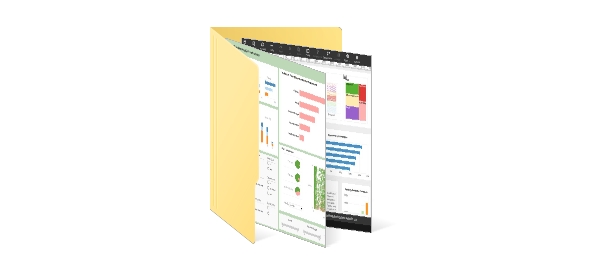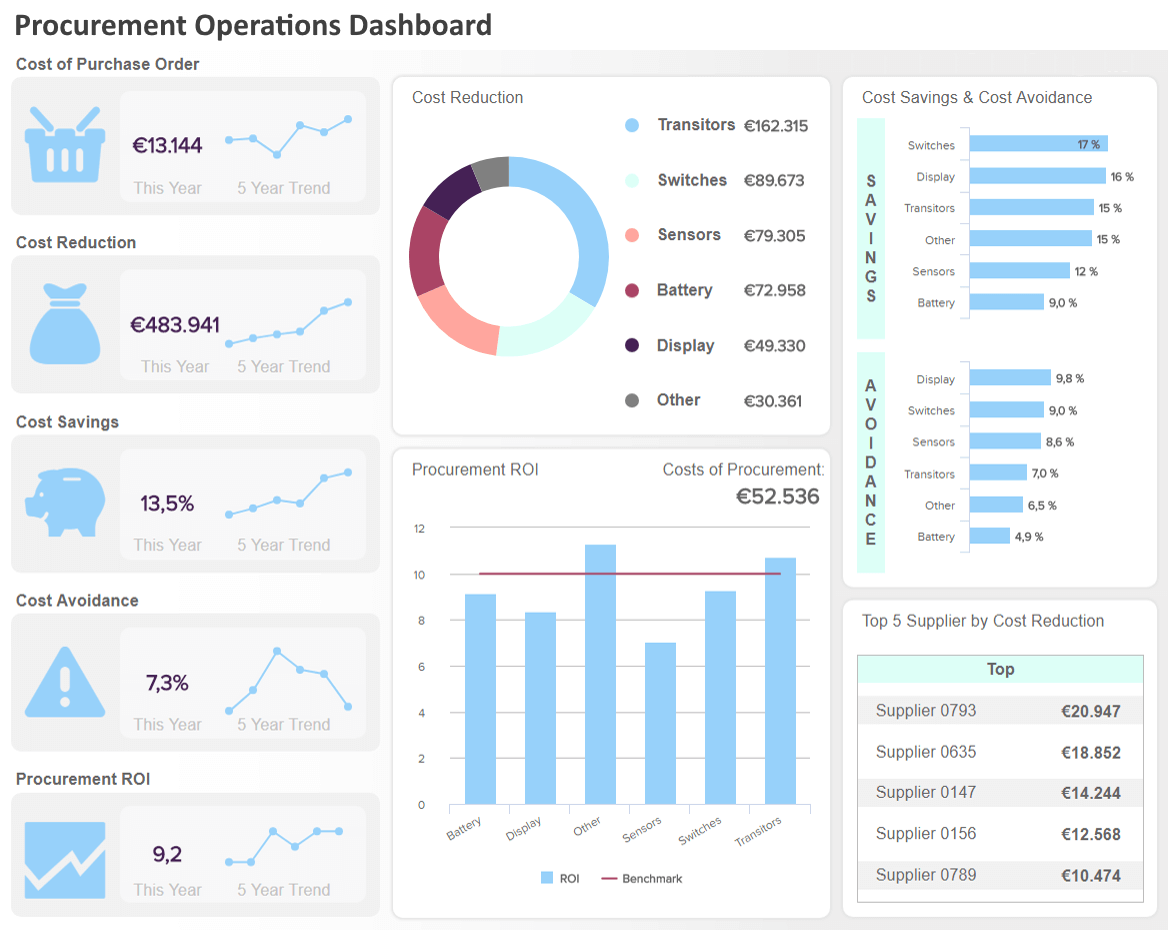What KPIs and Analytics Does a Procurement Operations Analyst Use?
Organizations are realizing more and more how important procurement operations are for reducing costs, preserving relationships with suppliers, and streamlining supply chain operations. Businesses depend on procurement operations analysts to guarantee that procurement activities are operating at peak efficiency. These experts evaluate and enhance the efficacy and efficiency of procurement processes using analytics and Key Performance Indicators (KPIs).
In this article, we'll examine the important KPIs and analytics used by procurement operations analysts to strengthen procurement procedures and advance larger corporate goals.
| #1 Ranking: Read how InetSoft was rated #1 for user adoption in G2's user survey-based index | Read More |
Cost Savings and Cost Avoidance
Cost reduction and cost avoidance are two of the main goals of procurement operations. The term "cost savings" describes the decrease in procurement expenses achieved via bargaining, strategic sourcing, and supplier management. The goal of cost avoidance, on the other hand, is to reduce wasteful spending via rigorous contract management and supplier selection. These variables are tracked and analyzed by procurement operations analysts to make sure that procurement activities support cost-cutting objectives and directly impact the organization's bottom line.
Supplier Performance and Quality
Analysts in procurement operations are aware of the significance of choosing and keeping a strong supplier base. They use a variety of KPIs to evaluate supplier performance, including on-time delivery, lead times, product quality, and contract compliance. Analysts may identify poor suppliers and take remedial action to reduce supply chain disruptions by monitoring these variables. Additionally, keeping a solid network of suppliers improves the general quality of the items and services the firm purchases.
 |
View the gallery of examples of dashboards and visualizations. |
Purchase Order Cycle Time
An essential component of simplifying operations and ensuring company continuity is having effective procurement procedures. The duration from the start of a purchase order to its final approval and delivery of products or services is measured by the buy order cycle time, a crucial parameter. This KPI is examined by procurement operations analysts to identify bottlenecks and delays in the procurement process. Cycle time reduction may boost production, boost customer happiness, and better manage cash flow.
Spend Analysis and Category Management
Spend analysis is carried out by procurement operations analysts to provide thorough insights into expenditure trends. In order to find chances for consolidation, bulk discounts, and strategic sourcing, procurement data must be classified and analyzed. Businesses may minimize erratic spending by using spend analysis to make better choices and negotiate better contracts. Spend analysis enables businesses to harness their buying power and enhance their procurement strategy when combined with efficient category management.
Supplier Diversity and Sustainability
Supplier diversity and sustainability have grown significantly in relevance in recent years in procurement processes. Businesses are placing more and more emphasis on finding products and services from a variety of vendors while guaranteeing ethical and sustainable business practices. Supplier diversity data, such as the proportion of spending with diverse suppliers and supplier development initiatives, are tracked and evaluated by procurement operations analysts. In order to match with the organization's corporate social responsibility objectives, they also evaluate the sustainability efforts of suppliers, including environmental and social responsibility policies.
Contract Compliance
The basis of a successful procurement process is a contract. To minimize legal risks and maximize the value generated from supplier partnerships, contract compliance must be ensured. By keeping track of compliance with terms, conditions, and service level agreements, procurement operations analysts keep an eye on contract compliance. Analysts may protect the organization's interests by spotting instances of non-compliance and taking appropriate remedial action, renegotiating terms, or replacing providers, if needed.
Inventory Management
Inventory management is another task performed by procurement operations analysts. They assist in finding a balance between maintaining ideal inventory levels and preventing excessive carrying costs by monitoring inventory turnover ratios and demand forecasting accuracy. A smooth manufacturing process and reduced stockout risk are two benefits of effective inventory management, which also improves supply chain efficiency.
Supplier Risk Management
To prevent possible supply chain disruptions, procurement operations analysts evaluate and manage supplier risks. They examine elements including reliance on a single supplier, geopolitical hazards, and financial stability. Using this information, analysts may create risk mitigation measures, diversify their supplier base, and create backup plans to protect the procurement process from unforeseen difficulties.
 |
View the gallery of examples of dashboards and visualizations. |
Supplier Evaluation and Scorecards
Supplier scorecards are created by procurement operations experts to assess suppliers' performance comprehensively. Metrics for quality, delivery effectiveness, responsiveness, price competitiveness, and general customer satisfaction may be included in these scorecards. Analysts may discover top-performing vendors and areas that need improvement by routinely evaluating these ratings. This information promotes long-term relationships with dependable suppliers and helps in the selection of vendors for future procurement requirements.
Purchase Requisition to Purchase Order Ratio
By monitoring the amount of buy requests that actually result in purchase orders, this KPI gauges the effectiveness of the procurement process. A low ratio could be a sign of inefficiencies in the procurement workflow or requisition approval process bottlenecks. In order to enhance the conversion rate and decrease procurement delays, procurement operations analysts look into the causes of requisitions that are refused.
Procurement ROI and Cost-Benefit Analysis
Analysts do cost-benefit studies and determine the Return on Investment (ROI) for procurement projects in order to show the company the worth of procurement operations. They may determine the regions where investments provide the maximum returns by weighing the expenses of procurement operations against the benefits received. This study assists in resource allocation optimization and stakeholder justification of procurement-related expenses.
 |
Learn about the top 10 features of embedded business intelligence. |
Maverick Spending
Expenditure outside the traditional procurement procedure, often avoiding negotiated contracts or favored suppliers, is referred to as maverick expenditure. By examining data from several departments or business units, procurement operations analysts keep track of expenditure that is beyond the norm. Analysts may take action to enforce procurement regulations, restructure the procurement process, and promote compliance by determining the scope of this non-compliant expenditure.
Purchase Price Variance
The difference between the agreed-upon or anticipated price and the actual amount paid for products or services is known as the purchase price variance. This KPI is used by procurement operations analysts to evaluate the accuracy of supplier pricing and negotiate better prices with suppliers. Organizations may find potential for cost savings and keep a handle on procurement expenses by routinely analyzing buy price variation.
Savings Tracking and Forecasting
For the purpose of assessing the performance of procurement programs, tracking and projecting cost reductions arising from procurement operations is essential. Analysts in procurement operations compare actual savings to expected savings to spot any gaps or potential areas for improvement. Setting sensible procurement goals, assisting budgetary choices, and coordinating procurement tactics with overarching corporate goals are all made easier with the use of this knowledge.



